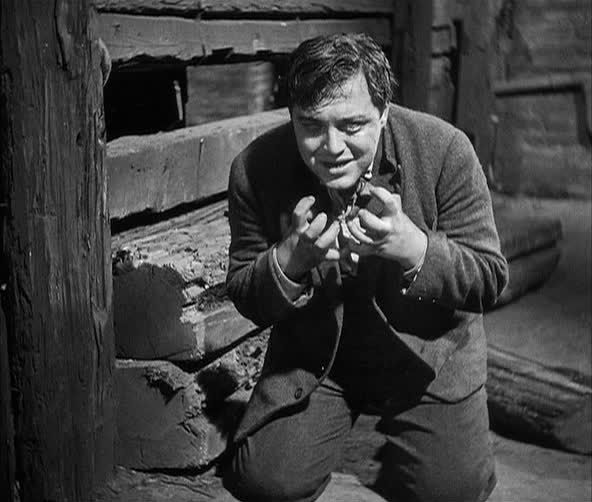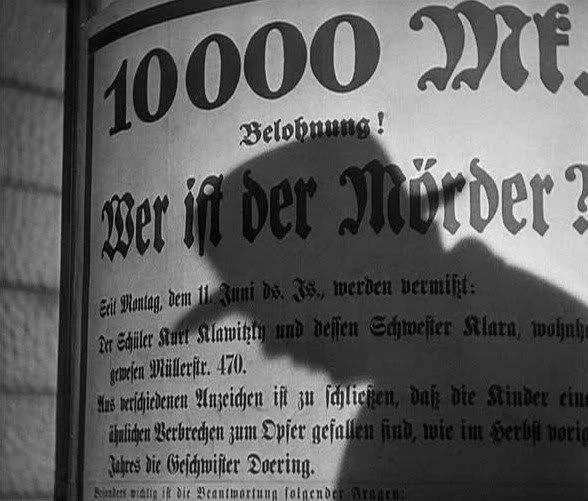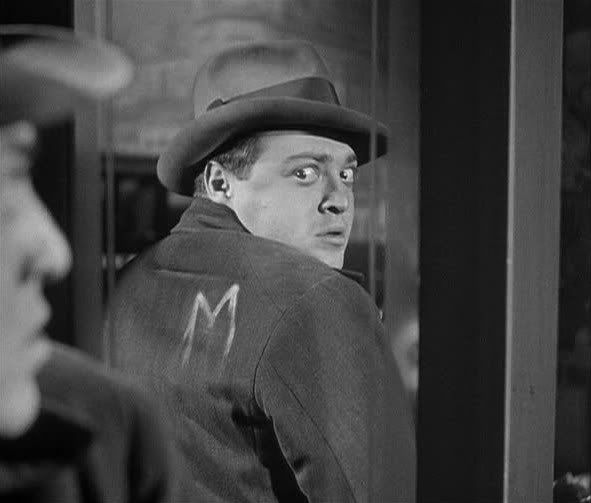
Fritz Lang's M was the director's first sound film, and the penultimate film he made in Germany before emigrating to the USA, fleeing the encroaching takeover of the Nazi party. It is, even today, a strikingly modern film, tackling a very sensitive subject from a surprising angle. Lang's classic tells the story of the search for a child killer who's terrorizing a German city, eluding capture while kidnapping and murdering children that he meets on the streets, luring them with candy and toys. And yet the film is not concerned with the mystery of these killings — the murderer is identified very early on as Hans Beckert (Peter Lorre) — nor is it a thriller focusing on the fear of the victims, which is the conventional approach to films about psychopathic serial killers. Instead, Lang focuses on the paranoia and other effects that these killings have on the city, as well as the killer's own feelings of terror and confusion.
Indeed, Lang accomplishes the miraculous feat of making the killer an almost sympathetic figure in some ways, a figure to be pitied as much as despised or feared. Beckert is portrayed by Lorre as a weak, pathetic, fearful man overcome by compulsions and desires that he can't control. He's pathetic and vile, but his actions are portrayed unambiguously as the product of a mental disfigurement that he is hopeless to resist, and that apparently a stay in a mental hospital could not cure. The film does a remarkable job of portraying Beckert's crimes as a sickness, very different from the usual sort of crime, a product of a diseased mind that, as Beckert exclaims at the film's climax, "really can't help it." He is a desperate man, writing letters to the police and the newspapers that all but beg for them to catch him and stop him, and Lorre's bug-eyed, sweaty performance is incredibly powerful. After one of his crimes, Lang inserts a shot of Beckert looking in the mirror, pulling down the corners of his mouth with his extended middle fingers, stretching his face into a scowl of misery. Later, echoing this shot, he is innocently window-shopping and happens to catch a reflection of a little girl standing behind him; his face becomes deformed, his idle chores forgotten, and he begins whistling "The Hall of the Mountain King," the signature tune that stands for his compulsions.
That song is virtually the only music in the film, which has no proper score and only uses whatever scant music appears within the diegesis. Towards the beginning of the film, Beckert's whistling precedes his first visual appearance, as he approaches a young girl, whistling, his shadow cast onto a poster announcing a reward for the killer's capture. It's a sinister image, and the whole scene is chilling for the suggestive way that it chronicles Beckert's predation without any overt violence. The girl's death is signaled with an evocative pair of shots: her ball rolling out of the bushes in a remote, overgrown area, followed by a shot of the smiling, human-shaped balloon that Beckert had bought for her, now drifting freely, getting tangled up in power lines. Meanwhile, at home the girl's mother fruitlessly calls out for her, expecting her home from school, and Lang cuts from the mother at the window, yelling the girl's name, to a series of static, empty, eerily silent shots of the apartment building's staircase and basement, devoid of life or movement. Lang elegantly uses such minimalist aural and visual symbols to tell his story, often replacing images of people talking with images of their shadows reflected on walls.

Lang is also concerned with depicting the killer's effect on the city. People are riled up and paranoid, and they begin responding with suspicion and violence at the least provocation: innocent men are accosted by mobs on the streets, friends accuse one another, anonymous letters point fingers at various random men, whose houses are searched and ransacked for clues by the police. The criminal underworld is also stirred up, as the police conduct raids of red light districts and bars, trying to uncover anyone the least bit suspicious, working on the assumption that the killer must be a shady character in general. These raids cause the criminal gangs, eager to catch the killer and end this intensified police activity, to start pursuing the killer themselves, aided by a network of beggars keeping an eye out for any sign of the murderer.
The general atmosphere of suspicion and persecution suggests a social and political response to this crime that is, in fact, disconnected from its origin. The cops raid bars without discrimination, arresting anyone whose papers are not in order, an eerie premonition of the ways in which the Nazis would shortly begin treating citizens. Lang was at this time growing increasingly concerned about the Nazis' ascent to power, even as his own wife Thea von Harbou, who co-wrote M with him, joined the party, alienating her from the partly Jewish Lang. Thus the film depicts a multifaceted nightmare where fear waits in every direction: a mother's fear for her child's safety, a criminal's fear of being apprehended, but also the more general fear of the innocent being sucked into the vicious whirlwind of a society riven by hysteria, as in the scenes where innocent men suffer in various ways for Beckert's crimes.

What's most interesting about M is the degree to which Lang lets all these different currents run together without emphasizing one over the other. Lang cuts between different segments of society — at one point blending together a meeting of the police and a meeting of some gangster bosses to ironically point out the similarities between cops and crooks — and different characters, never building a real solid central presence. Lorre's Beckert comes closest to fulfilling that role, though he's almost entirely absent for the first half of the film, only occasionally appearing as a reminder of the one man who's generating all the chaos in the city. Much of the film's second half, though, seems to stick closest to Beckert's perspective, particularly in the harrowing sequences where the killer is pursued through the streets by beggars, eventually cornered in the attic of a building, where the criminals track him down. The beggars even mark him with an "M" drawn in chalk on his jacket — another striking bit of Nazi foreshadowing — and the scene where he discovers this mark in a mirror recalls all the earlier mirror shots involving Beckert. Lang, interestingly, has crafted a suspense sequence in which nobody could possibly be rooting for Beckert to get away, and yet his terror, his increasing desperation, is nevertheless potently communicated by Lorre's performance and the shadowy, expressionistic mise en scène. Further enhancing the tense atmosphere is the fact that Lang shot many scenes entirely silent, only occasionally piercing the hush with bursts of clamoring police sirens or the shouts of the killer's pursuers.
M is many things: a powerful depiction of violent malaise, a searing critique of the death penalty and vigilante justice, a psychological study of fear and guilt, a vision of societal violence and fear that serves as a prelude to the rise of the Nazi Party. It remains such an affecting film in large measure because of how deftly Lang weaves together all these ideas, destabilizing audience expectations at every turn. Even today, so long after it was made, the bravery and modernity of Lang's ideas and his cinematic approach to this material is bracing and impressive.
Have you ever had a chance to see the Losey remake? It's not so much "underrated" as utterly ignored. It's quite a contrasting rendition as it's set in dwontown L.A. -- beautifully utilized by Losey asif it were built to his own design -- and stars David Wayne in a performance utterly different than Lorre's. While lorre gobsmacked audiences (and became a star) with the sympathy he evokes for this demented killer, Wayne asks for none. He's a monster from first to last.
ReplyDeleteDavid, I'll have a piece about the Losey remake up tomorrow. I think it's really interesting, in that it's almost a shot-for-shot remake at times, and yet it's very different in terms of the themes and tone it's exploring. Losey's version definitely needs more attention.
ReplyDelete"Lang is also concerned with depicting the killer's effect on the city. People are riled up and paranoid, and they begin responding with suspicion and violence at the least provocation: innocent men are accosted by mobs on the streets, friends accuse one another, anonymous letters point fingers at various random men, whose houses are searched and ransacked for clues by the police. The criminal underworld is also stirred up, as the police conduct raids of red light districts and bars, trying to uncover anyone the least bit suspicious, working on the assumption that the killer must be a shady character in general. These raids cause the criminal gangs, eager to catch the killer and end this intensified police activity, to start pursuing the killer themselves, aided by a network of beggars keeping an eye out for any sign of the murderer."
ReplyDeleteBravo! This early Lang is arguably the greatest German film ever made, which is no small achievement when you take in the rest of this towering director, early Murnau, G.W. Pabst, Fassbinder, Kluge, Herzog and others. It would also place on the shortlists of the vast majority of cineastes as among the greatest films of all-time. As you astutely note it is "a strikingly modern film" and one that better examines the paranoia of the killer and the terror of a city more compellingly than any film before or after. Likewise, the film does indeed persuasively portray the crimes as a deep-rooted sickness, and astonishingly the film makes this "Vampire of Dusseldorf" a sympathetic figure, even with the actual crimes the worst known to mankind.
The use of sound in the film, revolutionary at the time, remains as provocative as as any other work in the cinema, especially during the murder sequences which were accompanied by the whistling of the opening bars of "In the Hall of the Mountain King" from Grieg's 'Peer Gynt'. (as you acknowledge here)
A number of shots and sequences in the film are unforgetable, including the ball rolling out of the bushes, the shot of the balloon (Lewton used such devices a decade later in CAT PEOPLE and THE LEOPARD MAN) and other minimalist flourishes. The stylized realism of the sets and the dominant motif of destiny are powerfully transcribed, and the film purportedly features some real life criminals and thief. The use of buildings and clautrophobia is impressively conveyes, and there's more than a dash of Pabst's THREE PENNY OPERA and Brecht. The film is a piercing cry for compassion, and the kangaroo court sequence at the film's conclusion is deeply affecting.
Peter Lorre's performance is simply electrifying.
Another extraordinary analysis on a seminal work of the cinema. I completely agree with David, and look forward to your follow-up on the Losey re-make.
Terrific analysis.
ReplyDelete'M' and 'Dr. Mabuse der Spieler' are probably my two favorite Langs.
Also, Pynchon's 'Gravity's Rainbow' (which I'm rereading right now) evokes the strange paranoia of Lang's work on almost every page. Too bad Lang's no longer around to film this sprawling phantasmagoria. Can't imagine a Losey remake, as Lang's original is so deeply engraved in my head.
Thanks as always for the comments, Sam. What I find most striking about the film, as you say, is that it makes Lorre's killer so sympathetic and poignant, while also emphasizing how vile his crimes are, a really remarkable feat. As you point out, the film has been hugely influential, its images reverberating through many later films.
ReplyDeleteMark, interesting comparison there, I wouldn't have thought of Pynchon but now that you've made the connection it's definitely a resonant linkage. Give the Losey remake a chance though, it's both very similar and, in some ways, very distinct.